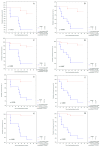A Preliminary Evaluation of Advanced Oxidation Protein Products (AOPPs) as a Potential Approach to Evaluating Prognosis in Early-Stage Breast Cancer Patients and Its Implication in Tumour Angiogenesis: A 7-Year Single-Centre Study
- PMID: 38473424
- PMCID: PMC10930735
- DOI: 10.3390/cancers16051068
A Preliminary Evaluation of Advanced Oxidation Protein Products (AOPPs) as a Potential Approach to Evaluating Prognosis in Early-Stage Breast Cancer Patients and Its Implication in Tumour Angiogenesis: A 7-Year Single-Centre Study
Abstract
Breast cancer (BrC) is a highly prevalent tumour among women. The high incidence and mortality rate of BrC prompts researchers to search for new markers that will provide information on the possible impact of the therapy on the risk of cancer-related events. This study aimed to investigate whether the level of advanced oxidation protein products (AOPPs) may have a potential impact on disease-free (DFS) and overall survival (OS) in BrC patients with early-stage cancer. Additionally, we tried to assess the relationship between AOPPs and angiogenic parameters. In this study, the pre- and post-treatment AOPP levels were examined in the serum of 70 newly diagnosed BrC women. The receiver operating characteristic curve identified pre- and post-treatment AOPPs to be above 9.37 μM and 10.39 μM, respectively, as the best cut-off values to predict the risk of cancer relapse. Additionally, Kaplan-Meier survival analysis indicated that pre- and post-treatment AOPPs above 9.37 μM and 10.39 μM were associated with significantly poorer OS. The uni- and multivariate Cox regression analysis highlighted that lower levels of pre- and post-treatment AOPPs were associated with a longer duration without relapse or cancer-related death. A positive correlation between concentrations of pre-treatment AOPPs and vascular endothelial growth factor A, and negative correlations with levels of soluble forms of vascular endothelial growth factor receptor type 1 and 2, were found. In conclusion, AOPPs appear to have an important role in predicting cancer-related events and may potentially serve as a simple prognostic marker in clinical practice.
Keywords: AOPP; adjuvant treatment; disease-free survival; early-stage breast cancer; overall survival.
Conflict of interest statement
The authors declare no conflicts of interest.
Figures




Similar articles
-
Unraveling the Angiogenic Puzzle: Pre-Treatment sVEGFR1 and sVEGFR2 Levels as Promising Prognostic Indicators in Early-Stage Breast Cancer Patients.Int J Mol Sci. 2023 Aug 31;24(17):13508. doi: 10.3390/ijms241713508. Int J Mol Sci. 2023. PMID: 37686312 Free PMC article.
-
Advanced oxidative and glycoxidative protein damage markers in the elderly with type 2 diabetes.J Proteomics. 2013 Oct 30;92:313-22. doi: 10.1016/j.jprot.2013.03.034. Epub 2013 Apr 13. J Proteomics. 2013. PMID: 23587667 Clinical Trial.
-
Association of cerebrospinal fluid advanced oxidation protein products levels with early brain injury and prognosis of aneurysmal subarachnoid hemorrhage: A preliminary prospective study.J Stroke Cerebrovasc Dis. 2022 Sep;31(9):106635. doi: 10.1016/j.jstrokecerebrovasdis.2022.106635. Epub 2022 Jul 8. J Stroke Cerebrovasc Dis. 2022. PMID: 35816787
-
Overview of resistance to systemic therapy in patients with breast cancer.Adv Exp Med Biol. 2007;608:1-22. doi: 10.1007/978-0-387-74039-3_1. Adv Exp Med Biol. 2007. PMID: 17993229 Review.
-
AOPPs and the progression of kidney disease.Kidney Int Suppl (2011). 2014 Nov;4(1):102-106. doi: 10.1038/kisup.2014.19. Kidney Int Suppl (2011). 2014. PMID: 26312159 Free PMC article. Review.
Cited by
-
Breast Cancer: Extracellular Matrix and Microbiome Interactions.Int J Mol Sci. 2024 Jun 30;25(13):7226. doi: 10.3390/ijms25137226. Int J Mol Sci. 2024. PMID: 39000333 Free PMC article. Review.
-
Oxidative Stress in Breast Cancer: A Biochemical Map of Reactive Oxygen Species Production.Curr Issues Mol Biol. 2024 May 13;46(5):4646-4687. doi: 10.3390/cimb46050282. Curr Issues Mol Biol. 2024. PMID: 38785550 Free PMC article. Review.
References
-
- National Cancer Institute Female Breast Cancer: Cancer Stat Facts. [(accessed on 18 March 2023)]; Available online: https://seer.cancer.gov/statfacts/html/breast.html.
LinkOut - more resources
Full Text Sources

